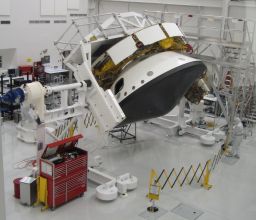Emily Lakdawalla • Dec 04, 2008
More details on the delay of Mars Science Laboratory
It was a lengthy press briefing today, with the four bigwigs on the press panel being exceptionally long-winded. Here's the short version, which I'll follow up with more detail.
- Unanticipated problems, principally with the motors and gearboxes (collectively called "actuators") needed to drive every moving part of the rover, have resulted in there simply not being enough time to prepare MSL for the planned October 2009 launch period.
- In particular, life cycle testing has not even begun for the actuators yet. Since MSL is planned to be a very long-lived mission, this is an unacceptable situation.
- A few-month delay would (probably) have been sufficient, but because Mars launch opportunities occur only about every 26 months, the only option was to delay to 2011.
- The added two years will be used to solve problems and to do additional testing; no substantive modifications to payload capabilities (i.e. adding instruments) will be permitted. The time will also be beneficial to incorporate lessons learned from the difficulties with sample handling experienced by Phoenix.
- The additional cost of the two-year delay is $300 to 400 million, resulting in a total life cycle cost of $2.2 to 2.3 billion.
- They believe the cost can be absorbed without canceling any planned missions, but "a delay to a major planetary mission" is likely. They will look within the Mars program for money first and then widen it to the rest of the planetary program.
- Looking beyond MSL to future Mars exploration, particularly Mars sample return, Ed Weiler announced a handshake agreement with his counterpart at ESA, David Southwood, to work together so that the future of Mars exploration will be a joint program between NASA and ESA.
Support our core enterprises
Your support powers our mission to explore worlds, find life, and defend Earth. You make all the difference when you make a gift. Give today!
Donate

 Explore Worlds
Explore Worlds Find Life
Find Life Defend Earth
Defend Earth


